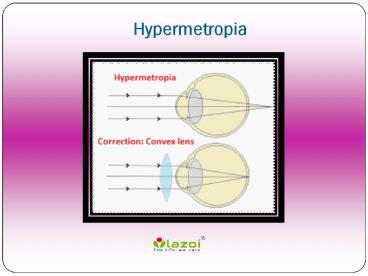Hypermetropia: Causes, Symptoms, Daignosis, Prevention and Treatment - PowerPoint PPT Presentation
Title:
Hypermetropia: Causes, Symptoms, Daignosis, Prevention and Treatment
Description:
Hypermetropia is an eye problem that causes blurry vision when focusing on nearby places and objects, but clear vision is there when focusing at a greater distance. – PowerPoint PPT presentation
Number of Views:227
Title: Hypermetropia: Causes, Symptoms, Daignosis, Prevention and Treatment
1
Hypermetropia
2
Hypermetropia
- Hypermetropia is an eye problem that causes
blurry vision when focusing on nearby places and
objects, but clear vision is there when focusing
at a greater distance. The condition is caused by
an eye that is shorter than normal, or a cornea
that's not as curved as it should be.Eyes that
are little misshapen won't be able to focus light
accurately onto the retina, which results in
blurred vision. There are several kinds of
irregular shapes than an eye can take, each
moving the focal point of the light away from the
retina, resulting in a different form of vision
impairment.
3
Hypermetropia
Continue
- When the shape of an eye aims light in front of
the retina, the resulting condition is called
myopia, or nearsightedness. A focal point behind
the retina is called hyperopia. - Corrective lenses are available for both
conditions, and are designed to move the focal
point to the surface of the retina, restoring
clear and focused eyesight.
4
The causes of hypermetropia
- Somehow hypermetropia is hereditary, but can
develop in anyone. It is possible to experience
symptoms even during childhood, but is much more
common later in life.In fact, anyone above the
age of 40 has a much greater chance of having
symptoms of hyperopia, with the likelihood
growing every year.Aging does not necessarily
cause the eyes to change shape any more, but it
does diminish the eyes ability to flex enough to
accommodate for the refractive error.
Additionally, some forms of hyperopia can be
caused by injury, drugs, or disease.
5
The causes of hypermetropia
Continue
- It's common for farsightedness to be confused
with presbyopia. Both of the conditions have
similar results - difficulty focussing on objects
that are near - but they have different causes.
6
What are the Symptoms of Hypermetropia?
- Everything may seem clear and in focus when
viewing at a distance more than a few meters
away, but any closer than that and things may
start to get blurry. The closer they get, the
less focused they become.As it becomes more
difficult to read and write, squinting will cause
eye strain and fatigue, leading to headaches.
7
How is Hypermetropia Detected and Treated?
- Farsightedness is not usually diagnosed in basic
eye-screenings because those tests only measure
the ability to see objects in the distance.If
an individual is found to be farsighted, a more
comprehensive optometrist examination should be
carried out to diagnose the condition.Corrective
eyeglasses, contact lenses, and even surgery can
all help to restore clear and focused
eyesight.Each has their own advantages and
disadvantages, though, and lifestyle, work
environment, and personal preference all play a
role in deciding which is best. You should
discuss with your eye care professional which one
is right for you.
8
How is Hypermetropia Detected and Treated?
Continue
- Eyeglasses are inexpensive and effective, but not
always convenient. If you have an active
lifestyle, or play sports, it may be difficult to
keep them firmly in place. They come in many
different shapes and sizes, and can be quite
fashionable. Tinted lenses are also available,
allowing you to stay protected from bright
sunlight and damaging UV rays. - Contact Lenses are much more subtle, providing no
change in your personal appearance at all.
They're designed to be worn all day long, and
removed at night. Several types of lenses can be
worn for varying lengths of time. With proper
hygiene and some practice, contact lenses are one
of the more versatile options for people looking
for corrective eye wear.
9
How is Hypermetropia Detected and Treated?
Continue
- Surgery is also an option - LASIK and PRK are the
two examples of surgical methods that reshape the
surface of the eye, allowing it to refract light
accurately without any need for corrective
lenses. This is a more expensive method of fixing
the problem, but it's also more permanent. The
recovery time is usually only a few days, but
only one eye is corrected at a time, so multiple
visits will be required. - For mild cases of hypermetropia, you may only
need to wear your corrective lenses when doing
tasks at close range - such as reading or using a
computer.Those who have more severe
hypermetropia, or who suffer from other
conditions like astigmatism, may need to wear
their lenses more often.
10
CONNECT WITH US
- Logon to
- www.lazoi.com
- Like us on Facebook
- https//www.facebook.com/LazoiTheLife
- Follow us on Twitter
- https//www.twitter.com/lazoithelife
- Follow us on Pinterest
- https//www.in.pinterest.com/lazoithelife































